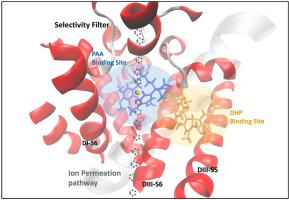Journal of Molecular Graphics and Modelling ( IF 2.9 ) Pub Date : 2020-10-22 , DOI: 10.1016/j.jmgm.2020.107776 Farag E S Mosa 1 , Suryanarayanan C 1 , Tianhua Feng 1 , Khaled Barakat 2

|
Selective calcium channel antagonists are widely used in the treatment of cardiovascular disorders. They are mainly classified into 1,4-dihydropyridine (1,4-DHPs) and non-DHPs. The non-DHPs class is further classified into phenylalkylamines (PAAs) and benzothiazepines (BZTs) derivatives. These blockers are used for the treatment of hypertension, angina pectoris, and cardiac arrhythmias. Despite their well-established efficiency, the structural basis behind their activity is not very clear. Here we report the use of a near-open confirmation (NOC) model of the Cav1.2 cardiac ion channel to examine the mode of binding of these antagonists within the pore domain as well as the fenestration of the pore-forming domains. Effects of calcium ion permeation in the presence of drug molecules were assessed using steered molecular dynamics (SMD) simulations. These studies reveal that nicardipine, a DHP derivative, shows a strong Cav1.2 blocking activity, requiring more 2500 pN force to pull calcium ion towards the channel’s pore in the presence of the compound. Similar blocking activity was observed for verapamil, a PAA derivative, requiring almost 2300 pN of force. The least blocking activity was observed for Diltiazem, a BZT derivative. Our results explain the structural basis and the binding details of 1,4-DHPs, PAAs and BZTs at their distinct Cav1.2 sites and offer detailed insights into their mechanism of action in modulating the Cav1.2 channel.
中文翻译:

选择性钙通道阻滞剂对离子通过人Cav1.2离子通道渗透的影响:计算研究
选择性钙通道拮抗剂被广泛用于治疗心血管疾病。它们主要分为1,4-二氢吡啶(1,4-DHP)和非DHP。非DHP类别进一步分类为苯烷基胺(PAA)和苯并硫氮杂((BZTs)衍生物。这些阻滞剂用于治疗高血压,心绞痛和心律不齐。尽管它们具有公认的效率,但其活动背后的结构基础并不十分清楚。在这里,我们报告使用Cav1.2心脏离子通道的近开放确认(NOC)模型来检查这些拮抗剂在孔结构域内的结合方式以及成孔结构域的开窗。使用转向分子动力学(SMD)模拟评估存在药物分子时钙离子渗透的影响。这些研究表明,DHP衍生物尼卡地平显示出强大的Cav1.2阻断活性,在存在该化合物的情况下,需要更多的2500 pN力才能将钙离子拉向通道的孔。对维拉帕米(一种PAA衍生物)观察到了类似的阻滞活性,需要近2300 pN的力。对于BZT衍生物地尔硫卓,观察到的阻断作用最小。我们的研究结果解释了1,4-DHP,PAA和BZT在其不同的Cav1.2位点的结构基础和结合细节,并对它们在调节Cav1.2通道中的作用机理提供了详细的见解。对维拉帕米(一种PAA衍生物)观察到了类似的阻滞活性,需要近2300 pN的力。对于BZT衍生物地尔硫卓,观察到的阻断作用最小。我们的研究结果解释了1,4-DHP,PAA和BZT在其不同的Cav1.2位点的结构基础和结合细节,并对它们在调节Cav1.2通道中的作用机理提供了详细的见解。对维拉帕米(一种PAA衍生物)观察到了类似的阻滞活性,需要近2300 pN的力。对于BZT衍生物地尔硫卓,观察到的阻断作用最小。我们的研究结果解释了1,4-DHP,PAA和BZT在其不同的Cav1.2位点的结构基础和结合细节,并对它们在调节Cav1.2通道中的作用机理提供了详细的见解。


























 京公网安备 11010802027423号
京公网安备 11010802027423号